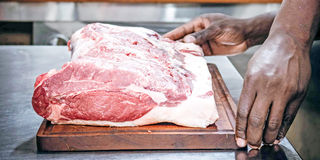Steps that meat industry actors are expected to follow to ensure the product on your table is safe
Sponsored by Kenya Meat Commission

Kenya’s meat industry is guided by a number of laws. Key among them are the Meat Control Act Cap 356, Public Health Act Cap 242, Standards Act Cap 496, and Food, Drugs and Chemical Substances Act Cap 254.
These, together with internationally recognised food safety standards, such as ISO 22000:2018 and HACCP (Hazard Analysis and Critical Control Point), guide meat value-chain actors in playing their part towards ensuring the product that finally gets to your table is safe for consumption.
For starters, livestock are sourced from disease-free areas. They are inspected at source by the county meat inspector, before issuance of a movement permit to facilitate transportation of the livestock to the slaughterhouse. The permit enhances the traceability of the final product.
At the slaughter house, the livestock are subjected to another round of ante-mortem inspection. This is conducted by an independent and authorised meat inspector. The process is aimed at ensuring that any animal suspected to be diseased or is not fit for slaughter, is held in the suspect pen for further inspection, or condemned straightaway for destruction. The animals that exhibit healthy clinical signs are then issued with acceptance notes for slaughter.
The slaughterhouse personnel must then implement quality control measures to ensure the meat remains safe. These include maintaining individual hygiene, proper cleaning and sanitation, pest control, allergen management, prevention of cross-contamination, and waste management, as well as carrying out post-mortem inspection and verification of the final product.
The personnel carrying out the slaughter must have undergone food handler medical examination, personnel hygiene training, and food safety awareness training, to ensure they contribute to the production of safe meat. Slaughtering requires volumes of water. The water must be clean and safe to avoid introducing a food safety hazard into the meat.

KMC staff during one of the editions of the Nairobi International Fair.
The post-mortem inspection is conducted through incision, palpation and observation of the carcass muscle, head, tongue, liver, lungs, spleen, heart, kidney, blood, uterus, mammary glands, lymph nodes, and hooves. This thorough check enables the detection of conditions such as tuberculosis and sarcocystosis, and presence of liver fluke, bladder worms, roundworms, tapeworms, abscesses, and pleural pneumonia, among others, that would render the meat not fit for human consumption.
This final inspection enables the authorised meat inspector to stop the release of non-conforming/not fit for human consumption products to the value-chain, hence preventing the spread of food-borne illnesses.
Meat can be sold fresh or chilled. The microbial quality of chilled meat is improved due to the inhibition of growth of microorganisms at temperatures below 40C. This is why cold chain management is a necessity in meat processing.
Meat is a highly perishable product, and to extend its shelf life, it should be stored at a temperature below 40C. A break in the cold chain management leads to the growth of pathogenic microorganisms that cause foodborne illness.
Consumers should be aware that control of meat storage as well as distribution temperatures affect the quality and safety of meat. Consuming meat that has not undergone both ante-mortem and post-mortem inspections is a health risk.


